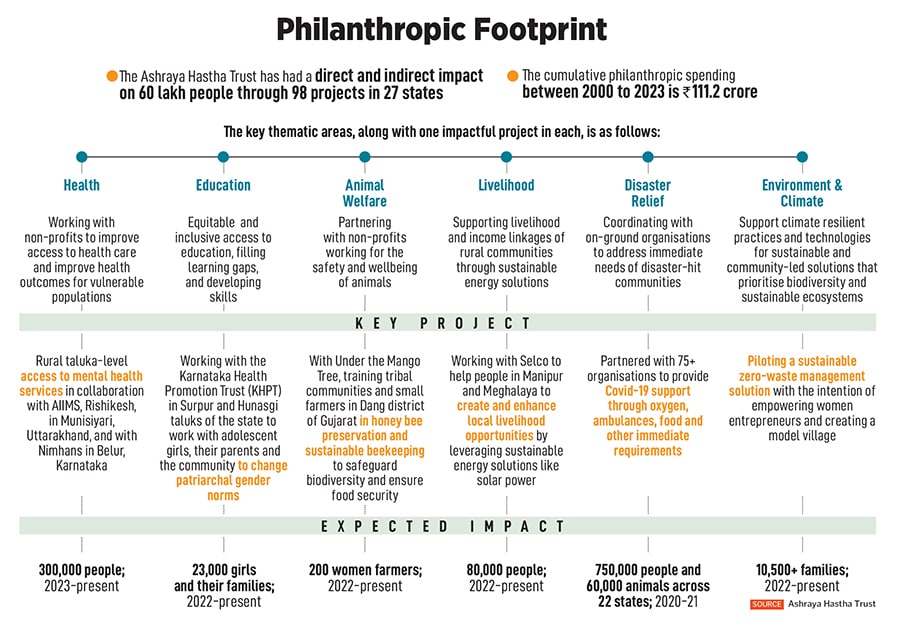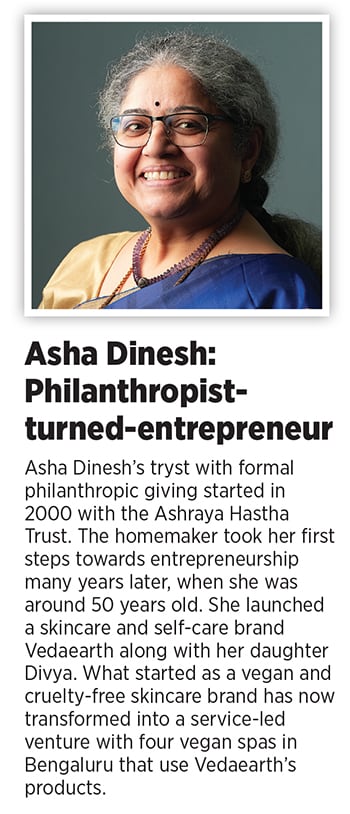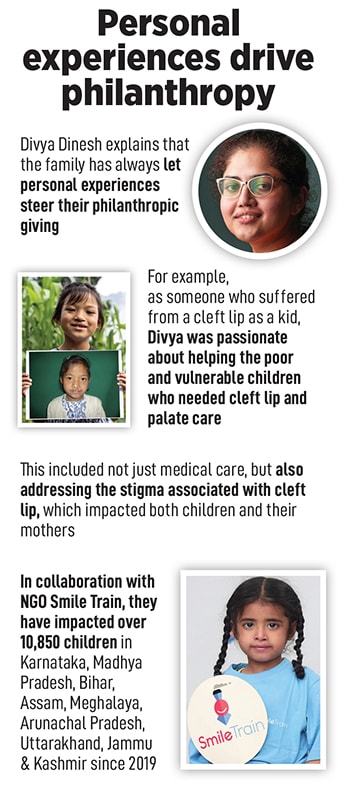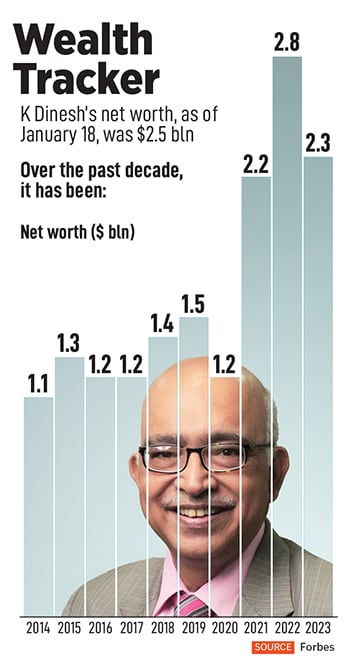K Dinesh and family: The generous givers
From health and education, livelihood, animal welfare, and environment and climate, and even disaster relief, K Dinesh's philanthropic endeavours span several causes and organisations to make a vast,


K Dinesh loves telling stories. His face broadens with a smile as he narrates them. “That’s not the end of the story," he says often, making room for an incoming twist in the tale.
One such anecdote is about how he got his first job in the software industry. He was applying for a programmer/analyst’s role in the public sector company, New Government Electrical Factory (NGEF). “Have you seen a computer?" the interviewer asked. Of course he had not seen one.
This was the early 70s, when there were just a few hundred computers in use in India. “I had never seen a computer, never used one, or even studied anything about it, but somehow computers fascinated me," Dinesh says over a Zoom call in early January.
The interviewers wanted to know how Dinesh could program a computer if he had never seen one. “I know how to spell computer," he had replied, making them laugh. “I told them that I don’t know anything, but I am keen to learn. With some training, they can help me do my job. And if I did not learn, only I will be the loser."
Dinesh refers to this willingness to learn at multiple points during our conversation, which stretches for over an hour. This penchant for learning new things and taking up challenges would go on to impress another interviewer, NR Narayana Murthy, about three years down the line in 1976.

Murthy, who was the head of software at Patni Computer Systems, gave Dinesh his next job in Mumbai—then Bombay—after NGEF. A few years later, in 1981, Dinesh became one of the seven co-founders of Infosys, a career move that would redefine not just his life, but also the software industry in India.
 The billionaire status that Dinesh enjoys today as a result of Infosys—his net worth as of January 18 is $2.5 billion, according to Forbes—makes him feel like life before the 80s was a story from another lifetime. In 1971, he had obtained a BSc degree in Physics, Chemistry, and Mathematics when he was just 17. In 1972, his first job as an RMS sorter in the Q Division of the Madras platform at the Bangalore City railway station paid him a stipend of ₹80 a month, and required him to sort letters as per then introduced PIN code throughout the night and in moving trains to Harihar. His second job was as a phone inspector with the telephones department, and his third was as a clerk with UCO Bank, before he landed at NGEF.
The billionaire status that Dinesh enjoys today as a result of Infosys—his net worth as of January 18 is $2.5 billion, according to Forbes—makes him feel like life before the 80s was a story from another lifetime. In 1971, he had obtained a BSc degree in Physics, Chemistry, and Mathematics when he was just 17. In 1972, his first job as an RMS sorter in the Q Division of the Madras platform at the Bangalore City railway station paid him a stipend of ₹80 a month, and required him to sort letters as per then introduced PIN code throughout the night and in moving trains to Harihar. His second job was as a phone inspector with the telephones department, and his third was as a clerk with UCO Bank, before he landed at NGEF.
Even during his career at Infosys, Dinesh wanted to give back to society. It was possibly in the ‘middle class’ DNA of the organisation, which also perhaps explains why the Infosys co-founders are among the most generous philanthropists among their peers today.
Dinesh started devoting himself to personal philanthropy more since he stepped down from the Infosys board in 2011, but he had started institutionalising it since 2000, when he launched the Ashraya Hastha Trust (AHT) along with wife Asha and his father-in-law S Nanjundiah, a retired army Major. His daughters, Divya and Deeksha, were also closely associated with it right from the start, and formally joined around 2013.
Last year, Dinesh took things a step further. For the first time in over 20 years, he brought his philanthropy in the public eye by becoming the “most generous new entrant" in the EdelGive Hurun India Philanthropy List, which list pegged his donation for FY23 at ₹47 crore. “Giving is very important, but having given, it is also important to set an example for others, so that there may be many more inspiring stories. That is the purpose of making sure it is known," says 69-year-old Dinesh, adding that the idea was influenced by his daughter Divya.
The influence of family is central to Dinesh’s philanthropy. Or, as he says it, while the money comes from the wealth created at Infosys, the motivation was always there. It goes far back to his childhood in rural Karnataka, where he was the fifth child among eight and studied in a Kannada medium school. His father was a school headmaster and his mother, Savitriamma, a homemaker.
 Dinesh remembers how she used to cook a whole lot of food every day. “We used to ask why she is making so much food for just a few people at home. She used to say, ‘It won’t go waste, because my family also consists of my neighbours, the vegetable and milk vendor, and the person who will come to our doorstep begging for food’," he recollects. His mother had only studied up to the seventh grade, but she taught him how people who are fortunate enough to have wealth should take care of those who don’t.
Dinesh remembers how she used to cook a whole lot of food every day. “We used to ask why she is making so much food for just a few people at home. She used to say, ‘It won’t go waste, because my family also consists of my neighbours, the vegetable and milk vendor, and the person who will come to our doorstep begging for food’," he recollects. His mother had only studied up to the seventh grade, but she taught him how people who are fortunate enough to have wealth should take care of those who don’t.
He found the same sense of dynamism and purpose in his wife Asha, with whose father they co-founded their family trust. He is also inspired by his daughters, who, from time to time, gave the trust a new sense of purpose and direction. To date, the Ashraya Hastha Trust (AHT) has had a direct and indirect impact on 60 lakh vulnerable and marginalised people through 98 projects in 27 states. The cumulative philanthropic spending between 2000 and 2023 is ₹111.2 crore.
“Dinesh and the AHT take up causes not just for people, but for the planet as well, and they take it up at a mission-level, so it is not mere grant-making," says Pritha Venkatachalam, partner and co-head, Asia and Africa at the global philanthropy and nonprofit advisory organisation, The Bridgespan Group. She adds that several causes Dinesh and his family have taken up—animal welfare, for instance—are not very common in philanthropy and are significantly underfunded and less understood needs.
While Dinesh and Asha had started out with causes largely related to education, health care and disaster relief, Divya and Deeksha were responsible for spreading the wings of their philanthropy to emerging causes like animal welfare and climate change. “In the early days, we did not have the kind of employees we have right now. It was just mom and dad. They went to all the places, asked questions, found out information and took decisions on funding," says Divya. “It’s only in the last five to eight years that we started doing things in a more structured manner."

Even though they have employees to oversee diligence and implementation, Asha continues to visit the places where they are funding projects. “While I go visit the NGOs we have partnered with, I also like to visit the beneficiaries of our philanthropy. I want to find out whether our support is reaching the right people and helping them as we intended."
 She adds that their initial steps into philanthropic giving was by observing the elders in their family, and watching how they went out of their way to help their neighbours or members of their community in the daily course of life. They also started with causes they could connect with. One of their initial projects, she explains, was helping public schools in villages, including Basarikatte and Neelakantanahalli in Karnataka. “These were mostly government schools that did not have the infrastructure, lacked a few classrooms, libraries or well-equipped labs. We got these schools equipped with whatever they needed," Asha says.
She adds that their initial steps into philanthropic giving was by observing the elders in their family, and watching how they went out of their way to help their neighbours or members of their community in the daily course of life. They also started with causes they could connect with. One of their initial projects, she explains, was helping public schools in villages, including Basarikatte and Neelakantanahalli in Karnataka. “These were mostly government schools that did not have the infrastructure, lacked a few classrooms, libraries or well-equipped labs. We got these schools equipped with whatever they needed," Asha says.
Dinesh adds that as philanthropists, it is their responsibility to nudge beneficiaries to reach their full potential. “Leadership is also showing people what they are capable of. We have to do that by asking the right questions, paving the way for them to look at new way of doing things."
He gives the example of the Basarikatte government school, which they have been supporting for over 20 years now. When the school authorities first approached them for funds, the pass-out rate of their students was at 67 percent. They said they could not reach 100 percent since they may not have well-qualified teachers, and, in any case, the average rate in neighbouring schools was around 40-odd percent. “They were hinting that they were already the best, then why was I asking them to improve?" recollects Dinesh, who told them that while he will extend some support, he will not visit them until they reach 100 percent. The school authorities came back in three years, informing him that they had achieved the target. “That’s not the end of the story," Dinesh says. In another three years, 70 percent of their students achieved distinction.

The authorities had managed to do that by observing in which subjects the students did not perform well, and instead of trying to teach them at the high school level, they started laying the groundwork in middle school itself. So when the students came to high school, they understood the subjects better. “This is the kind of systemic interventions you can bring through catalytic investments," Dinesh says. “In social sector, people have not been asked to do better than what they are doing. If we can show that aspirational value through leadership, they will rise to the occasion."
First Published: Feb 02, 2024, 11:25
Subscribe Now